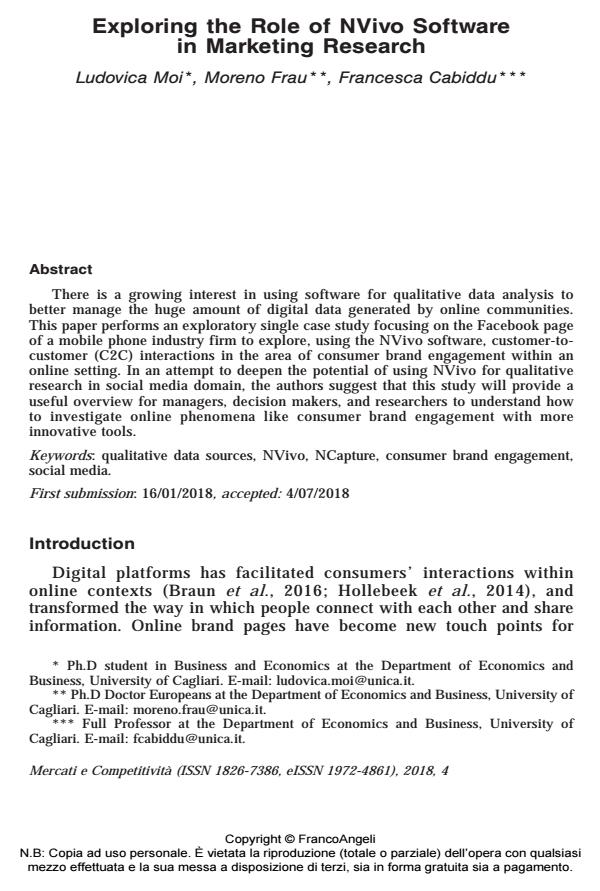Exploring the Role of NVivo Software in Marketing Research
Titolo Rivista MERCATI & COMPETITIVITÀ
Autori/Curatori Ludovica Moi, Moreno Frau, Francesca Cabiddu
Anno di pubblicazione 2018 Fascicolo 2018/4
Lingua Inglese Numero pagine 22 P. 65-86 Dimensione file 512 KB
DOI 10.3280/MC2018-004005
Il DOI è il codice a barre della proprietà intellettuale: per saperne di più
clicca qui
Qui sotto puoi vedere in anteprima la prima pagina di questo articolo.
Se questo articolo ti interessa, lo puoi acquistare (e scaricare in formato pdf) seguendo le facili indicazioni per acquistare il download credit. Acquista Download Credits per scaricare questo Articolo in formato PDF

FrancoAngeli è membro della Publishers International Linking Association, Inc (PILA)associazione indipendente e non profit per facilitare (attraverso i servizi tecnologici implementati da CrossRef.org) l’accesso degli studiosi ai contenuti digitali nelle pubblicazioni professionali e scientifiche
There is a growing interest in using software for qualitative data analysis to better manage the huge amount of digital data generated by online communities. This paper performs an exploratory single case study focusing on the Facebook page of a mobile phone industry firm to explore, using the NVivo software, customer-tocustomer (C2C) interactions in the area of consumer brand engagement within an online setting. In an attempt to deepen the potential of using NVivo for qualitative research in social media domain, the authors suggest that this study will provide a useful overview for managers, decision makers, and researchers to understand how to investigate online phenomena like consumer brand engagement with more innovative tools.
Parole chiave:Qualitative data sources, NVivo, NCapture, consumer brand engagement, social media.
- Leading digital transformation through an Agile Marketing Capability: the case of Spotahome Ludovica Moi, Francesca Cabiddu, in Journal of Management and Governance /2021 pp.1145
DOI: 10.1007/s10997-020-09534-w - Analisi dei fattori determinanti l'adozione dell'Intelligenza Artificiale in sanità Francesco De Domenico, Guido Noto, Carlo Vermiglio, in MECOSAN 128/2024 pp.135
DOI: 10.3280/mesa2023-128oa18595 - The Palgrave Handbook of Interactive Marketing Moreno Frau, Luca Frigau, Francesca Cabiddu, Francesco Mola, pp.987 (ISBN:978-3-031-14960-3)
- Seeding innovation: the role of internal and external digital data in agri-food product innovation Moreno Frau, Tamara Keszey, in British Food Journal /2024 pp.286
DOI: 10.1108/BFJ-08-2023-0687 - Crisis, Chaos and Organizations Ludovica Moi, Simone Serpi, Francesca Cabiddu, pp.281 (ISBN:978-1-64802-780-2)
- The Phoenix Effect – Rising from crisis through digital collaboration – How crisis affects social enterprises’ digitalization for value co-creation? Hikmat Mursalzade, in Vezetéstudomány / Budapest Management Review /2025 pp.14
DOI: 10.14267/VEZTUD.2025.07-08.02
Ludovica Moi, Moreno Frau, Francesca Cabiddu, Exploring the Role of NVivo Software in Marketing Research in "MERCATI & COMPETITIVITÀ" 4/2018, pp 65-86, DOI: 10.3280/MC2018-004005